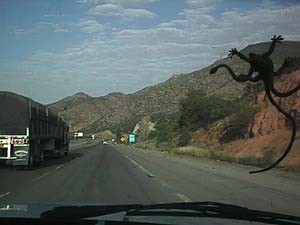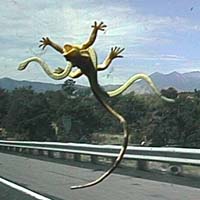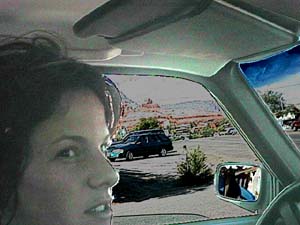im and I were still on Eastern Daylight Time even if we woke up this morning in the Mountain Time Zone in Santa Rosa, New Mexico. We didn't see any point in lingering in our motel room, so we immediately started packing up to resume driving. Again I took Sophie to the edge of the desert around the back of the Best Western, but since it was daylight I could see it in all its delicious unfamiliarity. I'm used to living in regions where I know most of the plants and trees by name. It's odd for me to look out across the rolling hills and see plants I can only now describe as "a kind of juniper bush, a fan-like grass with a sweet pulpy stalk and an ovoid cactus." Best Western gives away a "continental breakfast" with a night's stay, so we went over to the lobby and feasted on miniature bagels with cream cheese, orange juice and coffee, three cups of which we took with us.
s we continued west on I-40, I noticed in the full light of morning that, though the land was fairly flat and the hills were rather low, we'd entered a region of small canyons, some of which were spectacular to the eyes of this easterner. I was fascinated by the way the cube-shaped rocks lay in scattered piles. Then there they were, far off across the plain, the light blue lines of distant mountain ranges to the northwest and southwest. They were distinctly of the form of the western desert, with ends looking like the sides of mesas.
We stopped for overpriced gas and (for me) more coffee in Clines Corner and continued westward. The mountains drew closer. I remarked to Kim that they didn't look especially bigger than eastern mountains. From the distance they looked very much the same, though up close it was apparent they were really very big indeed and covered not with trees but bushes spaced at a certain regular frequency. Kim told me a little about what it's like to live in New Mexico, since she lived in Santa Fe in the summer of 1997 studying massage and teaching dance. She said that the earth tones of the arid landscape pervade absolutely everything and figures heavily into architecture and decoration. Looking out the window as the villages and settlements rushed past, I realized that even the most modern homes were made to look as if they were adobe shacks. Overpasses and other large concrete and metal structures were tinted, stained, painted or dyed to make them seem forged out of the landscape itself. After hours of looking at these colours, it all began to look like unfired pottery. East of Albuquerque the mountains were fully upon us, but instead of going up through any high pass we stated to go downhill dramatically among tightly-spaced steep mountain peaks dappled regularly with arid bushes. I had never seen something so distinctly western in my life.
e crossed the Rio Grande and entered a series of indian reservations. In the Acoma Reservation, we stopped at a Stuckeys for lunch. Unlike most of the rest of New Mexico, the Stuckeys stuck with its usual nauseating primary red and yellow colour scheme. I especially hated the bright yellow table tops, which looked as if they'd been stained by spilled omelettes. The stuckeys was just one end section of a store selling indian nick-nacks: dream catchers, velvet paintings, and other such crap. I went into the bathroom and the "Family Planning Center" had a metal plate hanging over the display with a sign advising people offended by such merchandise not to lift the plate. The staff of the restaurant were exclusively indians, all with the distinctly dishlike facial features and especially dark skin of their tribe. When Kim was ordering our food, she also ordered up an extra meat pattie for Sophie. The older lady cashier said she'd have to charge for a whole burger, so Kim ordered something smaller like a side of bacon. But when we looked to see what the younger female cashier had actually packed for us, we found two beef patties! Outside as we ate out food, I noted a pair of fellow travelers: a long-haired youthful dude wearing black boots, wallet chain and (unexpectedly) a tie-dye tee shirt. Like Monster Boy used to do, he was driving an older black sports car (a Trans-Am?). His girlfriend was dressed in a black slip and, like him, had dyed-black hair. With them they carried a black cat, which the dude took out to momentarily exercise. But he thought better of it when Sophie started whining and straining at her leash to investigate. Further west, we crossed a several-mile-wide swath of cracked and crumbling lava flows. It was black and ancient and (again) something I'd never seen before.
here was no special drama when we crossed the Continental Divide; the line across I-40 was just a low hill crossing the valley. At the Arizona border, the terrain mustered a brief flourish of characteristically Arizonan landforms: smooth, sandblasted orange buttes, arches and hollows, each surrounded with nick nack shops decorated with fake tepees, petrified stumps and plastic indians. But then the valley opened wide and returned to the typical New Mexican look of thin grasses and evenly-spaced bushes. Gradually the spaces between the bushes inflated, and eventually the bushes disappeared entirely, except in the middle of dry washes. This dry, desolate desert was in the vicinity of Winslow Arizona, which promotes itself with a reminder of the old Eagles song "Take It Easy."
Such a fine sight to see It's a girl my Lord in a flatbed Ford Slowin' down to take a look at me. The desert wasn't especially big, it was just a small region demonstrating an extreme of a trend that had begun back in Missouri. We rose up out of the desert to a pine forest in the vicinity of Flagstaff, which was set against a backdrop of dramatic mountains, including Humphreys Peak, 12,663 ft. above sea level. From here Kim wanted to go south down Oak Creek Canyon, her favourite place on Earth. But now she was exhausted and cranky from hours of driving, so I took over. Somehow I got on I-40 westbound for Los Angeles instead of I-17 southbound and didn't discover the error for some 15 miles. We found ourselves speeding through a dense montane pine forest, going nearly as high as 8000 feet at one point, by far the highest elevation I've ever been on land.
nce we got onto 89A southbound headed towards Sedona, we passed down out of the pines down tight switchbacks to the bottom of the Oak Creek Canyon. Incredibly beautiful vistas of red rock cliffs, each eroded into unique buttes and spires, opened up around every bend. It was much more impressive than I had expected. Originally I hadn't wanted to take this scenic detour, but now I was glad I had. I made extensive use of the Volvo's extra gear ranges as I did the descent, saving the brakes for some future day. I could smell the burning brakes of those less wise. We stopped at a little deli market place for beers, a sandwich, and some particularly flavourless curried pasta. The woman who checked our IDs before selling us beers later saw Kim walking Sophie and commented that the dog must belong to Kim's mother. Interestingly, that was same impression I had the first time I saw Kim and Sophie back on July 11th. I looked at the big deciduous trees along the river and for a moment could fool myself into thinking I was in the East. But the trees were all wrong. For example, the sycamores had soft droopy deep green leaves, not the crisp, yellowing bug-eaten leaves of the Eastern Sycamore. Downtown Sedona lies several miles downstream in the ever-widening canyon in the shadow of especially stunning red rock landforms, each named after various 20th-Century pop culture icons. Sedona had the look and feel of a tourist trap, especially on this relatively crowded Labor Day. Grannies in loud shirts led grandchildren cautiously across the main drag on endless treks for trinkets and souvenirs. I contented myself by taking a few digital photographs.
im originally wanted to get a hotel room in Sedona, but the crowds convinced her we should continue down to Phoenix and stay tonight with her aunt Rhonda. So we found our way back to I-17 and continued southward. The cellular phone proved useless in the low desolate mountains through which we passed. Gradually the plants changed. Ovoid cacti grew increasingly numerous, along with a kind of bush that appears to photosynthesize mainly with its swollen green stems (not its tiny vestigial leaves). The juniper-type bushes grew fewer and fewer in number until they all but disappeared.
e crossed a mountain range at something like 6000 feet and then gradually descended. Then on the south side of a ridge I saw my first Saguaro Cacti, single phallic stems. A couple ridges later they were one of the major forms of plant life. In the next community we passed I saw my first outdoor palm tree. We'd reached the subtropical desert.
From then on the cacti were part of the landscape, standing like figures on the hill. Each seemed to have its own personality. They could be sad, withdrawn, extroverted or flamboyant with whatever posture in which they happened to be frozen. Such alien organisms thriving in such abundance in such a clearly desolate land was to me the visual embodiment of what it means to struggle to survive and, by latching onto the few good things in the environment, succeed. Meanwhile, the palm trees were the most visible unfamiliar plant object in civilized areas. As we entered the northern suburbs of Phoenix, they lined the streets just like elms do in northern Ohio. When the cellular phone was operational again, Kim called Aunt Rhonda and arranged to meet her at the ranch where she stables her Arabian horses.
he ranch we sought was a dusty place in a fairly heavily-populated but not well-irrigated part of the desert in the northwest suburbs of Phoenix. By the barn, Kim recognized her aunt, a thin but busty forty-something dressed in jeans and a cowboy hat. She may have looked wild west, but when Rhonda spoke she conclusively proved that you can take the girl out of Detroit but you can't take Detroit out of the girl. She sounded exactly like her sister Bettie, but with more the conversational manner of her other sister, Kim's Mother. My mother once made a similar trajectory, having grown up in the Boston suburbs but then choosing to live in Yuma, Arizona where she rode horses and worked as a traveling art teacher. Rhonda showed us her various Arabian horses. Some were "going to nationals" and she was very proud of them. I wanted to know what horses were not going to nationals so I could give them the attention I felt they probably weren't getting. After awhile Rhonda's friend Gay (of similar age and bustiness) arrived with beer for us and carrots for the horses. I spent the next fifteen minutes doing my best to open the beers (Fat Tire Pale Ale or some such) without a proper opener, eventually settling on a hoof pick used to pick at manure-clogged hooves. While the others fussed over horses, I was mostly interested in the various dogs hanging out. There was a threesome of three big black dogs hanging out around the stable and two enormous Rotweilers in special pens some distance away. I unsuccessfully tried to make peace with the latter while for the first time scrutinizing both a palm tree and a Saguaro Cactus up close. The Saguaro seemed to have a problem with people backing their pickup trucks into it. I wondered how water is delivered to the palm trees. Was it by an underground hose that drips automatically, or was it watered in a more manual fashion?
e all climbed into our cars and Kim and I followed Rhonda and Gay in Rhonda's two-seat Mercedes back to her place. She lives in the Gainey Ranch, a heavily irrigated, gated and rather heavily guarded community in Scottsdale (a town immediately west of Phoenix). I noticed that the plates on Rhonda's car are from Medina, Ohio. Gay took off in her vintage El Camino, and Kim and I moved a bunch of our stuff up into a vacant room in Rhonda's condo. I was frazzled from driving, the dry desert heat, the unpacking, and an aggravating sore in my mouth. Rhonda has two miniature Schnauzers like Sophie. One is strikingly black and white and shy and her name is Demi. The other is old, sway-backed and grey; her name is Raven. Raven took a special shine to me (she has a reputation for falling in love with male humans), following me around and staring at me longingly. I was soon referring to her as my girlfriend. We three Homo sapiens took the three dogs for a walk in the golf course out in back. Lined on one side by a long narrow pond, it's a big grassy irrigated thing, completely out of place here in the desert. The only other person on the course was a man pushing someone in a wheelchair. This one witness forced Rhonda to go through the motions of acting like she was picking up dog poop whenever one of the dogs crouched to go "big potty" as she says. Back in the air-conditioned relief of Rhonda's condo, I sipped a vodkatea Kim prepared for me and we all prepared to go out for dinner.
e ended up at a friendly sushi bar, sitting at the actual bar itself, with Kim (who once worked as a sushi waitress) ordering up various rolls as if they were drinks. I remarked that sushi was "where food meets drugs" and it really did feel that way, especially the way I was doing it with huge dollops of wasabi. We sipped two different temperatures of saki and exchanged small talk. The place had a nice intimate ambiance, partly because (for the first half of our dinner) we were the only ones there. As we were preparing to leave, Kim got to talking to the sushi bartender about Shiatsu, the special Japanese form of massage that she'll be studying in San Diego. The bartender said he knew how to do it, and so Kim had him come out and demonstrate on Rhonda and her. Both he and Rhonda were being most flirtatious.
ext we went driving around in search of a gay bar, B.S. West, where, on a whim, we all wanted to go. Somewhere along the way Kim and I went into a bar to ask directions. The place was unexpectedly conceptual, trying to be a simulation of a section of New Orleans street, complete with iron balconies, old brick shopfronts and a blues band. Kim thought it was amazingly true to life. When we got there, Kim and Rhonda were the only girls in the gay bar with me, but nothing too interesting was going on. Rhonda was being very outgoing, walking up to tables of complete strangers and draping herself on the guys as a prelude to asking questions.
ack at Rhonda's gated community, Kim and I climbed the fence into the swimming pool and hot tub area. Kim tried to teach me to swim until, in aggravation, I told her that I don't want to be made to suffer through these lessons every time I get near water, that lots of people have wanted to teach me to swim, but that I haven't learned yet and I probably never will. We smoked a little pot and I was so drunk I nearly passed out.
|
 home |
musings index |
feedback |
other journals
home |
musings index |
feedback |
other journals






